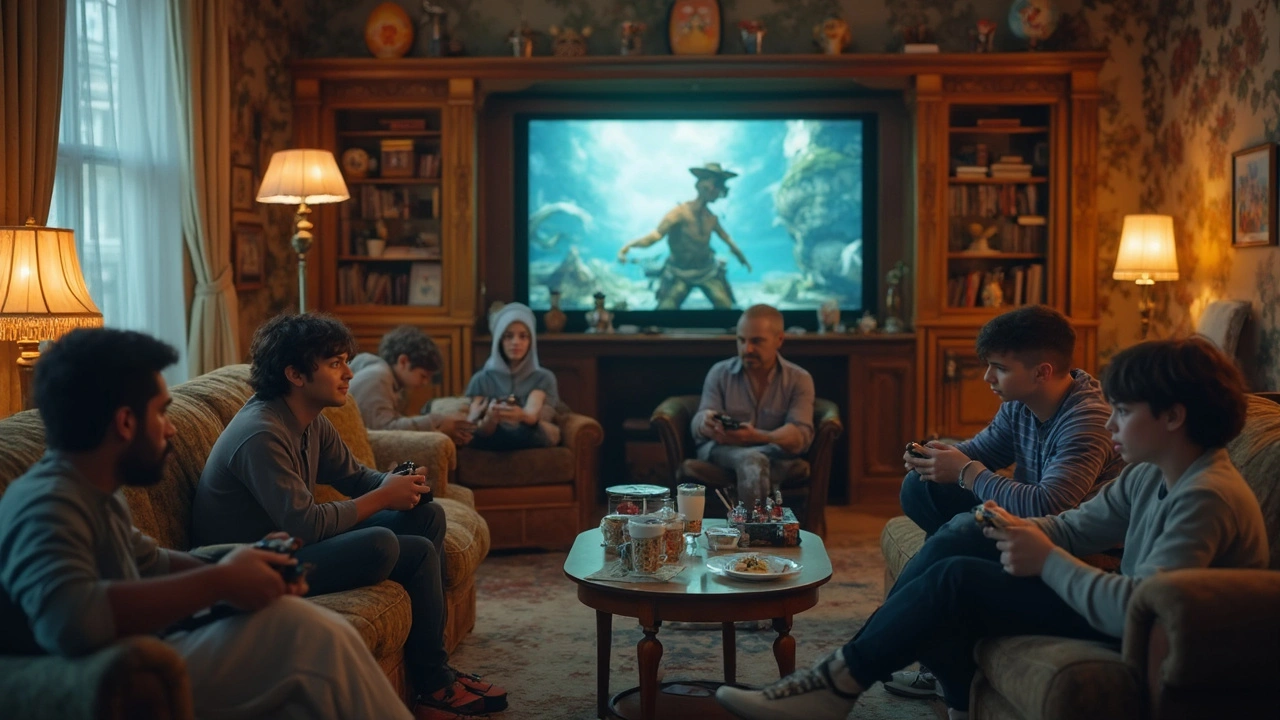When was the last time you went through a day without seeing an advertisement? Tough one, right? Ads are everywhere, but what's rapidly changing is how you see them, especially in games. In-game advertising is a hot trend now, blending ads directly into the gaming experience. It's like a digital billboard right inside your favorite games.
Why's this so cool? The gaming audience is massive—the industry pulled in over $200 billion last year, and people aren't just playing; they're living in these worlds. By placing ads where eyes naturally linger, marketers have a golden opportunity. It's not just about plastering logos; it's about making ads feel like part of the story. This means understanding the gamers themselves and crafting experiences that don't disrupt but enhance their gameplay.
There's a catch though—it's got to be subtle. Nobody wants an ad break in the middle of a boss fight. The goal is to be clever and unobtrusive, slipping into the background while still being visible. Think branded billboards in a racing game or a well-placed poster in a city landscape within a game. If done right, it's a win-win for both gamers and brands.
- The Rise of In-Game Advertising
- Making Ads Feel Natural
- Case Studies of Successful Campaigns
- Future Opportunities in Gaming
The Rise of In-Game Advertising
In recent years, in-game advertising has become one of the fastest-growing trends in digital marketing, taking the internet by storm. But why now, and why is it so effective? Well, it's simple. The gaming industry is booming. With over 3 billion gamers worldwide, this is not just an entertainment space but a massive platform brimming with potential. Whether you're cruising through the streets of a virtual city or battling mythical creatures, ads can seamlessly blend into these environments.
So, what's so special about this type of advertisement? First, gamers are highly engaged. They spend hours immersed in these experiences, far more than they do on social media or with traditional TV. This means brands have a captive audience that's ready to interact and engage with dynamic content.
Integration into Game Design
Developers are getting smart about incorporating ads without interrupting the flow. It's not just about ticking boxes but making sure ads are part of the gaming universe itself. This has led to innovative approaches like native ads and product placements. Imagine sipping on a well-known energy drink for a speed boost in your racing game. Sounds familiar?
Developing these experiences requires a close collaboration between game developers and marketers. The goal? Make the player feel the ad is a natural part of the scenery, not a forced addition.
Effective Strategies
Many brands are still figuring out their strategy, but some are ahead of the game. They're using in-game economies to give players real-world incentives like discounts or rewards for engaging with their brands in-game. This kind of alignment between real and virtual worlds can significantly enhance brand loyalty and recognition.
Interested to see cold hard facts? Here’s how the numbers stack up. Check out this simple table:
| Year | Estimated Global Revenue |
|---|---|
| 2022 | $138 billion |
| 2023 | $159 billion |
| 2024 | $182 billion |
| 2025 (est.) | $204 billion |
By tying ads to immersive experiences, marketers can ensure that gamers aren't just seeing an ad, they're part of it! This makes all the difference. Tomorrow's ads won't look like today's, and in-game advertising is leading that charge.
Making Ads Feel Natural
If you've ever found yourself completely immersed in a game, you've experienced how seamless in-game experiences can be. Now imagine seeing a well-placed in-game advertising that doesn't jerk you back into reality but enhances the virtual world. The trick is making these ads feel like a natural part of the environment.
Understanding Gamer Psychology
Gamers are smart. You can't just slap an ad on the screen and expect them to bite. Marketers need to dive deep into understanding what gamers want and expect. This means studying not just gamer behavior, but the aesthetics of the games themselves. Does it make sense to see a soft drink ad in a medieval fantasy game? Probably not. However, a poster promoting a fictional medieval tournament could fit right in.
Case in point, during the release of a popular basketball video game, an energy drink brand cleverly integrated virtual sponsorship banners along in-game courts. This didn't just look natural—it actually elevated the game's realism.
"The key is to integrate advertisements in ways that match the look and feel of the game. It's not about standing out; it's about fitting in." - Jane Smith, Digital Marketing Expert
Techniques for Seamless Integration
So, how do brands make ads blend in? Here are a few techniques:
- Native Advertising: Incorporate ads that reflect the game's universe. For instance, an action-adventure game set in a bustling city might include in-game billboards for a real-world brand.
- In-Game Products: Meant for games where players interact with items. A sports game might feature branded sports equipment used by the characters.
- Dynamic Ads: These change based on time or location, similar to real-life billboards. Players might see different ads each time they revisit a virtual location.
It's worth noting that in a recent survey, 70% of gamers claimed they were open to branded content that felt contextually relevant to their gaming experience.
Ultimately, the goal of in-game ads is to offer value without compromising the gaming experience. Done right, digital marketing in the gaming sector can enhance engagement and foster positive brand associations. Taking the time to understand and implement these strategies can lead to a successful in-game advertising campaign.

Case Studies of Successful Campaigns
Diving into in-game advertising, nothing speaks louder than real-world success stories. These case studies demonstrate the power of in-game advertising and provide inspiration for those looking to break into this unique form of digital marketing.
Nike in NBA 2K20
Nike, always at the forefront of creative marketing, nailed it in NBA 2K20. By integrating their branding within the gameplay itself, they turned virtual sports arenas into promotional platforms. Players saw their avatars wearing Nike-branded sneakers and apparel, tied into real-world product launches. The campaign didn't just generate visibility; it created a buzz as players flocked to buy the gear they'd seen their digital counterparts sport.
Coca-Cola's Partnership with FIFA
Coca-Cola is no stranger to innovation, especially in gaming. Partnering with FIFA during key tournaments, they plastered their branding across virtual stadiums. This wasn't just an edge-of-the-pitch banner ad situation, but a genuine sponsorship feel, calling back to their real-world football investments. Fans got a seamless experience—familiar sponsors enhancing realism and providing brand recall with each match.
Monster Energy's Presence in Death Stranding
Here’s a quirky one. When Death Stranding launched, players noticed protagonist Sam Bridges drinking Monster Energy drinks to boost his stamina. The partnership was bold and received a lot of chatter online. Gamers appreciated the novelty and direct interaction with the brand, as it played into both the mechanics and the lore of the world. It was unique, proving branded moments can be both integral and entertaining.
Data and Insights
Success stories stem from leveraging gamer psychology and ensuring ads fit the game universe. Let's look at some numbers:
| Game | Brand | Impact |
|---|---|---|
| NBA 2K20 | Nike | 20% increase in brand recall |
| FIFA | Coca-Cola | 25% engagement boost during tournaments |
| Death Stranding | Monster Energy | 15% spike in brand conversations online |
These examples prove something big—when done right, in-game ads aren't just impactful; they're game-changing. Brands need to consider how they can weave their story into the gaming experience to augment both their recognition and the fun of the virtual worlds they inhabit.
Future Opportunities in Gaming
Are you ready for the next big thing in in-game advertising? As the gaming industry skyrockets, there's a treasure trove of opportunities waiting for savvy marketers who jump in early. One cool trend is the advent of the virtual reality (VR) gaming space. Imagine slipping on a headset, and bam, you're in a new world. It's a whole new playground for marketers to explore innovative ad placements.
Virtual Reality: The Next Frontier
The global VR gaming market is projected to hit $50 billion by 2028. Companies are experimenting with VR ads that don't feel like ads. Picture interactive product placements where players can literally 'walk' into a branded store or interact with a new gadget.
Dynamic and Programmatic Ads
Say hello to dynamic ads that change based on real-time data. These ads aren't just stuck; they adapt to what's happening in the player's world, offering freshness and relevance. Programmatic buying, which automates ad purchasing using data analytics, is making a splash too. It's like a matchmaking service for ads and gamers, ensuring the right ads find their way to players who'll actually dig them.
Check out this brief glimpse of the potential growth:
| Year | VR Gaming Market Size |
|---|---|
| 2025 | $20 billion |
| 2028 | $50 billion |
The Indie Game Edge
Not all gamers are into the AAA titles. Indie games are gaining traction, offering quirky and unique environments. They're often more affordable for brands, providing a golden opportunity to slip in native ads without breaking the bank. These games usually have dedicated fanbases that are open to new experiences, making it a fertile ground for fresh advertising strategies.
Localization and Personalization
Finally, one size doesn't fit all. Brands need to tailor ads to local cultures and languages. Players notice details, and a personalized approach makes ads feel more like friendly nods rather than sales pitches. As gaming becomes more global, customization is key to truly resonating with diverse audiences.





